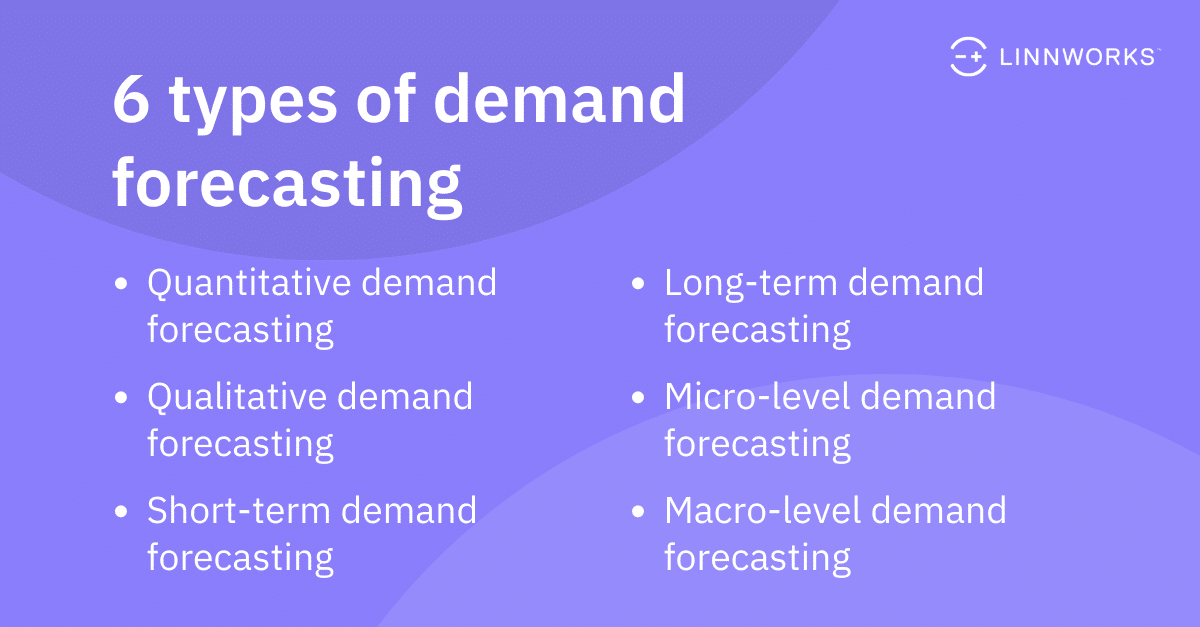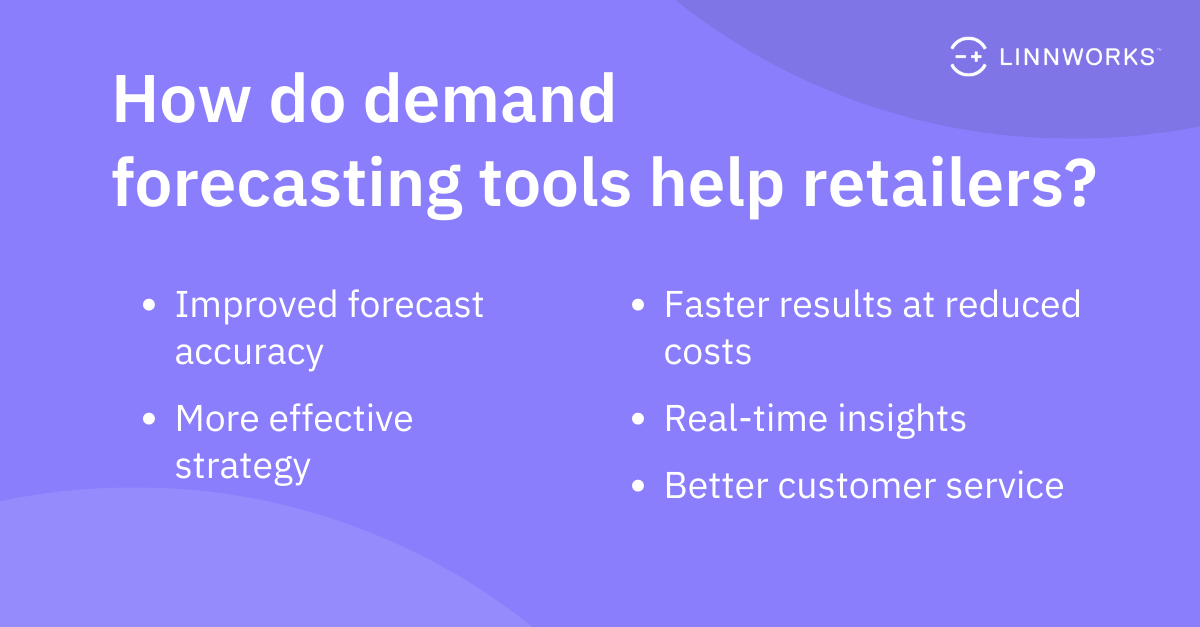Demand forecasting in the apparel industry
Ecommerce retailers face the challenge of predicting what products will sell, and where and when. Hitting the mark is crucial to minimize the risks of overselling or overstocking. Add in the challenge of predicting dynamic fashion trends, and you can see the importance of demand forecasting in the apparel industry.
Demand forecasting is the process of predicting future customer demand for a product or service. This information can be extremely helpful for fashion retailers for decisions about product development, pricing, promotions and inventory management.
But what goes into a demand forecast? And what are the benefits and drawbacks of using this type of tool?
Learn more about the benefits of demand forecasting and what methods are available to apparel businesses.
Why is accurate demand forecasting important for apparel retailers?
Accurate forecasting is crucial to make informed decisions related to production planning, inventory management, and pricing strategies. Forecasting can mean the difference between optimized or inefficient operations or between streamlined profitability and leaky costs.
Demand forecasting provides insights into consumer behavior that help you anticipate future demand for products. You can use this process to identify upcoming trends, historical patterns, and seasonality, enabling you to adjust your operations accordingly.
Demand forecasting is particularly important in the apparel industry, where fashion trends change rapidly because of the weather, seasonal patterns, influencers and consumer preferences.
Accurate demand forecasting informs your production schedules and inventory levels. When all those areas align, you avoid overselling and overstocking while meeting demand for your most popular products.
Demand forecasting in the fashion industry is also critical for retailers looking to set pricing strategies. When you can accurately predict demand, you can adjust prices to optimize profitability. Prices for apparel and fashion items already fluctuate under normal circumstances because of factors such as seasonality and trends. Getting ahead of those price swings can help you take advantage of the market rather than be at its mercy.
What are the different types of demand forecasting?
There are many types of demand forecasting models available to predict future demand.
Each of these models has advantages and limitations, and each business will need to decide which is most appropriate based on the specific business context and what data is available. Here are some of the most common types of demand forecasting.
Quantitative demand forecasting
Quantitative forecasting is a method based on numerical data.
It typically involves collecting data on factors such as the sales history of similar items, customer behavior, economic trends and seasonal trends. Then, you use mathematical models, statistical analysis and machine learning algorithms to make predictions about future customer demand.
Quantitative demand forecasting can help ecommerce businesses better anticipate customer needs and plan their inventory and marketing strategies accordingly.
Qualitative demand forecasting
Qualitative forecasting is a method that relies on data sources such as customer surveys, market research and past sales patterns.
It’s used to identify potential customer needs, preferences and trends, as well as to anticipate potential market changes.
Qualitative demand forecasting can help businesses make better decisions regarding product development, pricing, promotion and distribution, for example.
Short-term demand forecasting
Short-term forecasting is the process of predicting short-term customer demand for a product or service. It involves analyzing sales data, trends and customer behaviors to anticipate the amount of product and services needed during a certain time period.
This type of sales forecasting is especially important for ecommerce businesses, as it helps them plan inventory, manage cash flow and optimize pricing.
Long-term demand forecasting
Long-term forecasting is the process of predicting customer demand for products or services over a long-term period.
Such forecasts range from a few months to a few years. This method helps companies plan for the future and make high-level decisions about production, inventory, marketing and investment.
Long-term demand forecasting typically involves analyzing historical data and using complex statistical models to make predictions about future customer behavior.
Micro-level demand forecasting
Micro-level forecasting is the process of predicting future demand for individual products or product categories. This approach informs decisions related to pricing, inventory management and marketing, among other areas.
This method typically involves collecting data on customer behavior, external trends or other factors that have specific impacts. Then, you use predictive algorithms to analyze the data and extract insights.
Macro-level demand forecasting
Macro-level forecasting refers to the process of predicting customer demand for products or services at a higher level than micro-level demand forecasting. A macro-level forecast might focus on the level of a market segment or industry.
This process involves looking at overall market trends and making predictions about the likely demand for a particular product or specific service level. This type of forecasting can be used to inform product development, inventory management and marketing decisions.

5 benefits of using a demand forecasting tool
Accurate forecasts reflect a pattern of processes and behaviors that illustrate a well-run ecommerce business.
Effective forecasts are the result of organizations that prioritize trend research, understand their business and customers, and use the right tools and technology.
Here are five common benefits of using an effective fashion demand forecasting tool.
Improved forecast accuracy
Demand forecasting tools help businesses create accurate forecasts by using sophisticated algorithms to analyze past and current data.
While algorithms must be monitored and tested regularly, this approach removes much of the human error related to guesswork and gut feelings. You reduce the risk of inaccurate predictions while training the model to improve its forecasting as it receives new data.
More effective strategy
Accurate demand forecasting surfaces insights into customer behavior and preferences.
These insights aren’t just curiosities. They can inform decision-making processes throughout your organization, such as inventory for decisions and tracking, pricing strategies or decisions about what products you choose to sell.
For example, when you have strong confidence in your forecast of anticipated demand, you can adjust your pricing strategy to avoid overselling or resorting to markdowns.
Faster results at reduced costs
Demand forecasting tools automate the forecasting process, saving time, resources and money while generating more accurate, malleable and timely forecasts.
With processes syncing up, you’re not losing out on productivity while waiting for humans to act. This is an especially powerful benefit for companies with teams in different time zones.
Real-time insights
Demand forecasting tools provide real-time insights into demand patterns and help you identify and react to trends.
These tools give you instant updates so you’re no longer waiting until the next forecasting cycle to gather important information. In high-volatility markets like apparel, having a constantly updating dashboard gives you a competitive advantage and improves your decision-making.
Better customer service
By using demand forecasting tools, businesses have a better sense of what items will be popular, when they’ll be popular and what channels they’ll sell on.
With this intelligence in hand, you can improve customer service by preventing complaints. Fewer customers suffer from overselling because they can order the right product in the right amount at the right time.

The challenges of demand forecasting
Demand forecasting can be a challenging and time-consuming process that requires the right resources and expertise. It’s not a seamless process, especially if you’re revamping your forecasting processes or switching tools.
Here are some of the most common challenges you might encounter.
Incomplete or inaccurate data
Your demand forecast is only as accurate as your data. Inaccurate data can lead you to erroneous conclusions that create or exacerbate overstocking or overselling. The result? Lost sales and customer dissatisfaction.
Meanwhile, incomplete data can hamper your ability to identify trends and improve stock control. This leads to an inefficient use of resources and missing out on hot-selling items.
Not only do you need the right data, you need to have a way to test and verify before making decisions based on the forecast. If your model is heavily reliant on historical and seasonal patterns, for example, but new patterns emerge, your once-accurate data quickly becomes obsolete.
Time and resource constraints
While demand forecasting is getting more sophisticated and speedy, it still requires heavy use of data, analytics and predictive modeling to accurately predict customer demand.
Demand forecasting tools are a huge improvement over manual processes, but expect to spend time and resources to collect, analyze and assess data.
Forecasting also requires continuous monitoring and updating of data, which can be time-consuming and costly. This can become a major challenge for ecommerce businesses with limited resources and time constraints. Some sellers might face trade-offs in how granular they want forecasts to get.
Complex methods
Predicting customer demand relies on collecting data across categories, including sales histories, customer behavior, market trends and economic indicators. This data must be analyzed using sophisticated algorithms and models before you can accurately forecast future demand.
However, the sheer amount of data and complexity of the algorithms can be difficult to manage and can lead to inaccurate predictions — especially if your team struggles to understand the model itself.
Additionally, changes in the marketplace can cause unpredictable changes in customer demand or other data points. This increases the degree of difficulty and doesn’t always offer a clear path forward for how to adjust your demand forecasting tool
Inventory management issues
Having an accurate estimate of demand is essential for proper inventory management, as an inaccurate forecast can lead to costly inventory inaccuracies.
Overstocking can lead to increased costs associated with storage. In the apparel industry, your once-hot items could fall out of fashion while you’re trying to clear your backlog. Understocking, meanwhile, can result in lost sales and customers taking their business elsewhere.
With the speed and popularity of online shopping, it’s critical that you’re able to quickly and effectively adjust your inventory levels to meet customer demand. This requires accurate forecasting and an efficient inventory management system that adapts to changing needs.
Unexpected events
Even with powerful, accurate methodologies in place, your forecasts could be thrown off by unexpected and unpredictable events such as natural disasters, economic downturns or supply chain disruptions.
There’s no way to predict or prepare for every possible scenario. But when you have effective methods of demand forecasting and inventory and order management, you can mitigate these potential issues — or at least reorient your forecast.
The future of demand forecasting in the apparel industry
Technological advancements offer the potential for demand forecasting to continue becoming more accurate and less time-consuming. Emerging tech such as machine learning, artificial intelligence and big data could influence demand forecasting in significant ways, some of which we can’t anticipate.
Even as those technologies develop, demand forecasting in the apparel industry is already a powerful differentiator. Use these tools to make more informed decisions about product development, pricing, promotions and inventory management. Combine them with other automation technologies to optimize your operations and create an effortless shopping experience for your customers.
Inventory management system providers such as Linnworks can put an end to overselling and ensure you always have the products your customers need.
Learn how an effective inventory management system can help you reduce stock levels and avoid overselling.